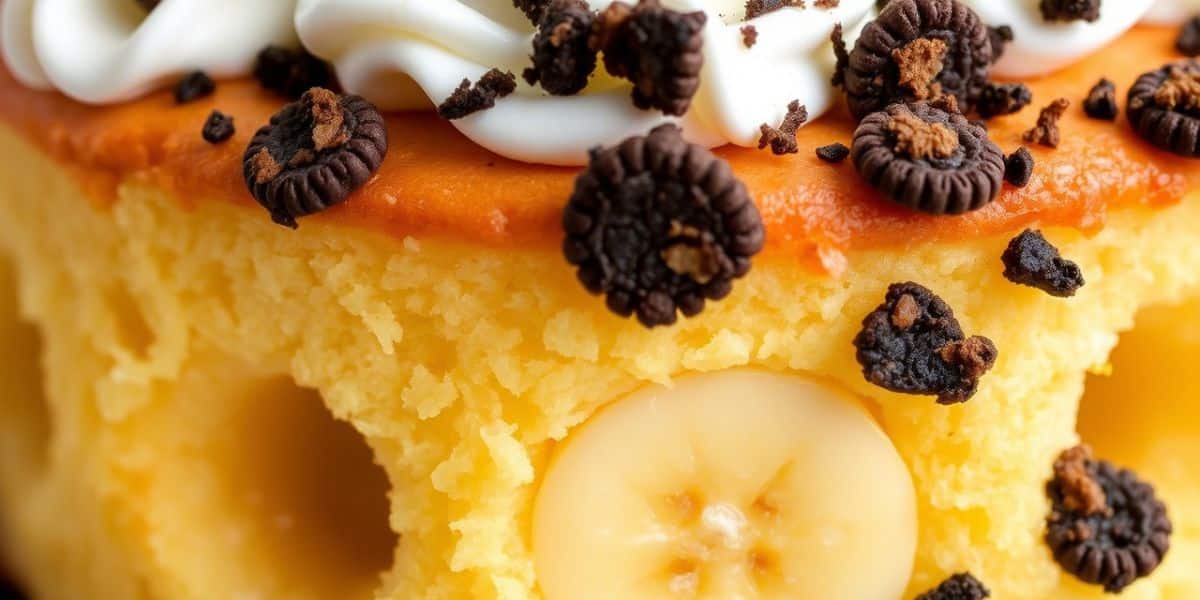If you think you’ve seen every twist on banana pudding, think again. The Banana Pudding Poke Cake isn’t just another dessert—it’s a mind-blowing mashup that flips classic baking on its head. Imagine a soft, moist cake that soaks up luscious banana pudding, bursting with flavor in every bite. This article dives deep into the why’s, how’s, and what’s of this remarkable treat. Whether you’re a professional baker or a seasoned home cook, there’s plenty here to sharpen your skills and inspire new creations.
What Makes a Poke Cake Different? The Science Behind It
You might wonder, “Why poke a cake?” It’s a bit counterintuitive—why stab a freshly baked cake on purpose? But here’s the magic: those holes act as reservoirs, soaking up liquid pudding, custard, or any flavorful filling you pour over. This technique transforms a regular cake into a moist, flavor-packed masterpiece.
From a technical perspective, the cake’s crumb structure plays a big role. Cakes with a tender but sturdy crumb hold up best. If the cake is too crumbly, the pudding will turn it into mush. Too dense, and the liquid won’t absorb properly. Striking that balance is a skill all pros need to master.
Choosing the Right Cake Base for Banana Pudding Poke Cake
Most poke cake recipes start with a boxed cake mix for convenience, but a professional baker knows the power of a scratch cake. A classic yellow or white cake is perfect because its mild flavor lets the banana pudding shine.
The key is to bake it slightly underdone—this helps maintain softness and ensures it absorbs the pudding evenly. Baking times vary, but reducing by 3-5 minutes from the package’s suggestion usually does the trick. Don’t just trust the toothpick test here; use your finger to gently press the cake’s surface. It should spring back slowly, not be completely firm.
Banana Pudding: The Heart of the Poke Cake
Here’s where the art meets the science. Banana pudding isn’t just a vanilla custard with bananas thrown in. The quality of the pudding dictates the entire dessert’s success.
Professionals swear by homemade custards because of their richness and control over sweetness. Using fresh ripe bananas instead of overly green or brown ones ensures the pudding is flavorful without turning bitter or mushy.
Store-bought instant pudding? It works but beware of overly artificial flavors and a waxy texture. A hybrid approach—mixing instant pudding with real custard—can be a smart shortcut without sacrificing quality.
The Poke Step: Techniques and Tips
Poking the cake isn’t random stabbing. To get uniform holes, use the handle of a wooden spoon or a similar blunt instrument. Space the holes about 1 inch apart, but adjust depending on the cake’s size.
Some bakers prefer poking while the cake is still warm, others after it cools slightly. Warm cake absorbs liquid faster, but if it’s too hot, it can cause the pudding to separate or become runny. Experimentation is key—professional kitchens often test batches to find the sweet spot.
Layering and Assembly: Building Flavor and Texture
After poking, pour the banana pudding slowly over the cake, letting it seep into each hole. Don’t dump it all at once; patience matters. Use a spatula to gently spread pudding over the surface without disturbing the cake too much.
For an elevated touch, add thin slices of fresh banana between layers or on top. Some chefs sprinkle crushed vanilla wafers or lightly toasted nuts for a textural contrast. These details elevate the poke cake from good to gourmet.
Storage and Serving: Maintaining Quality
Unlike many cakes, poke cakes get better after resting for a few hours or overnight in the fridge. This resting time allows the pudding to fully soak through, creating that creamy, almost molten texture.
However, don’t leave it too long uncovered. The exposed surface can dry out, and bananas may brown. Cover with plastic wrap or use an airtight container.
When serving, slicing a poke cake requires a sharp serrated knife to avoid squishing the cake and pudding. Wipe the knife between cuts for cleaner slices.
Common Mistakes and How to Avoid Them
- Too much liquid: Over-soaking can lead to soggy, unpleasant texture. Measure pudding carefully.
- Wrong cake texture: Using a dry or overly dense cake will ruin the absorption.
- Skipping the cooling step: Pouring pudding on a hot cake can cause it to break apart or separate.
- Ignoring banana quality: Overripe or underripe bananas drastically change flavor and texture.
Avoid these by testing and tasting at every step—professionals rely on sensory feedback over guesswork.
Emerging Trends: Variations and Innovations
Today’s top pastry chefs are pushing poke cakes beyond the traditional. Think caramel-banana pudding poke cake with salted caramel drizzle, or a tropical twist with coconut pudding and toasted coconut flakes.
Vegan and gluten-free poke cakes are also gaining ground. Using plant-based pudding and cake recipes without compromising on moisture is an exciting challenge many experts are tackling.
Why Professionals Should Add Banana Pudding Poke Cake to Their Repertoire
This dessert combines technique and creativity, offering a canvas for experimentation. It’s a crowd-pleaser with a rich backstory of Southern baking traditions. Mastering poke cakes sharpens your skills in cake texture, moisture management, and flavor layering—skills that translate across many other desserts.
Conclusion: Key Takeaways and Pro Tips
Banana Pudding Poke Cake isn’t just a dessert—it’s a lesson in precision and patience. Choosing the right cake base, crafting or selecting quality pudding, and mastering the poke technique make all the difference. Don’t rush the assembly or resting process; these steps turn simple ingredients into something extraordinary.
For professionals, pushing boundaries with flavor combos and dietary tweaks keeps this classic fresh and exciting. Keep experimenting, tasting, and refining. Your next poke cake could be the talk of the town.

Emily Rose Johnson is a talented writer known for her captivating storytelling and evocative prose, creating unforgettable characters and compelling narratives in various genres.









